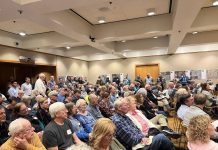Columbus has designated six areas of the city as Economic Revitalization Areas to streamline the process for businesses and industry looking to find a new home.
Robin S. Hilber, programs director for the city’s Community Development Department, said the six areas identified as economic revitalization areas will be:
Woodside Northwest, on the south side of Columbus
Progress Park, off U.S. 31 and Lowell Road
Columbus Municipal Airport, on Columbus’ north side
Indianapolis Road Industrial Corridor, leading out of the city to the north
State Street Industrial Corridor, from downtown to the east side of Columbus
Columbus’ downtown area
While individual parcels have been designated as an Economic Revitalization Area in the past, the new designation is designed to be more business-friendly when strategically attracting industry to specific areas, Hilber told the Columbus City Council last week.
Having an Economic Revitalization Area designation is required for businesses seeking a tax abatement, Hilber said. In the past, if a property being considered for development and abatement wasn’t in an economic revitalization area, an additional step was required to designate the property as such, she said.
With the permanent designation in the six areas, that step may be skipped and will speed up the tax abatement consideration process for business prospects, she said.
While declaring parts of the city as economic revitalization areas does streamline the process, it does not guarantee that any future business considering locating in one of the six areas would receive an abatement, she said.
Before the council voted to approve the designations, Columbus resident David Jones questioned why the city was making it easier for businesses to get tax abatements while at the same time approving a tax increase for city residents for the cumulative capital development fund to the maximum allowed by the state.
The tax rate, one of seven that makes up the overall city tax rate, will increase from $0.0316 to the state maximum of $0.05 per $100 in assessed value, adding about $13.50 for a taxpayer who has a home assessed at $150,000.
Hilber responded that vacant property generates far less in taxable income to the city than developed properties, and although the tax abatement is often for 10 years, businesses pay a gradually increasing rate through the decade until they are paying a full tax bill after year 10.
Businesses often invest millions in locating in Columbus and hire local residents as employees, adding economic traction to the city’s economy, Hilber said.
[sc:pullout-title pullout-title=”What is an Economic Revitalization Area” ][sc:pullout-text-begin]
A city designates an area as an economic revitalization area to spur economic development at specific locations. The designation encourages future redevelopment on vacant properties in the areas and streamlines the process of applying for a tax abatement from the city.
[sc:pullout-text-end]




